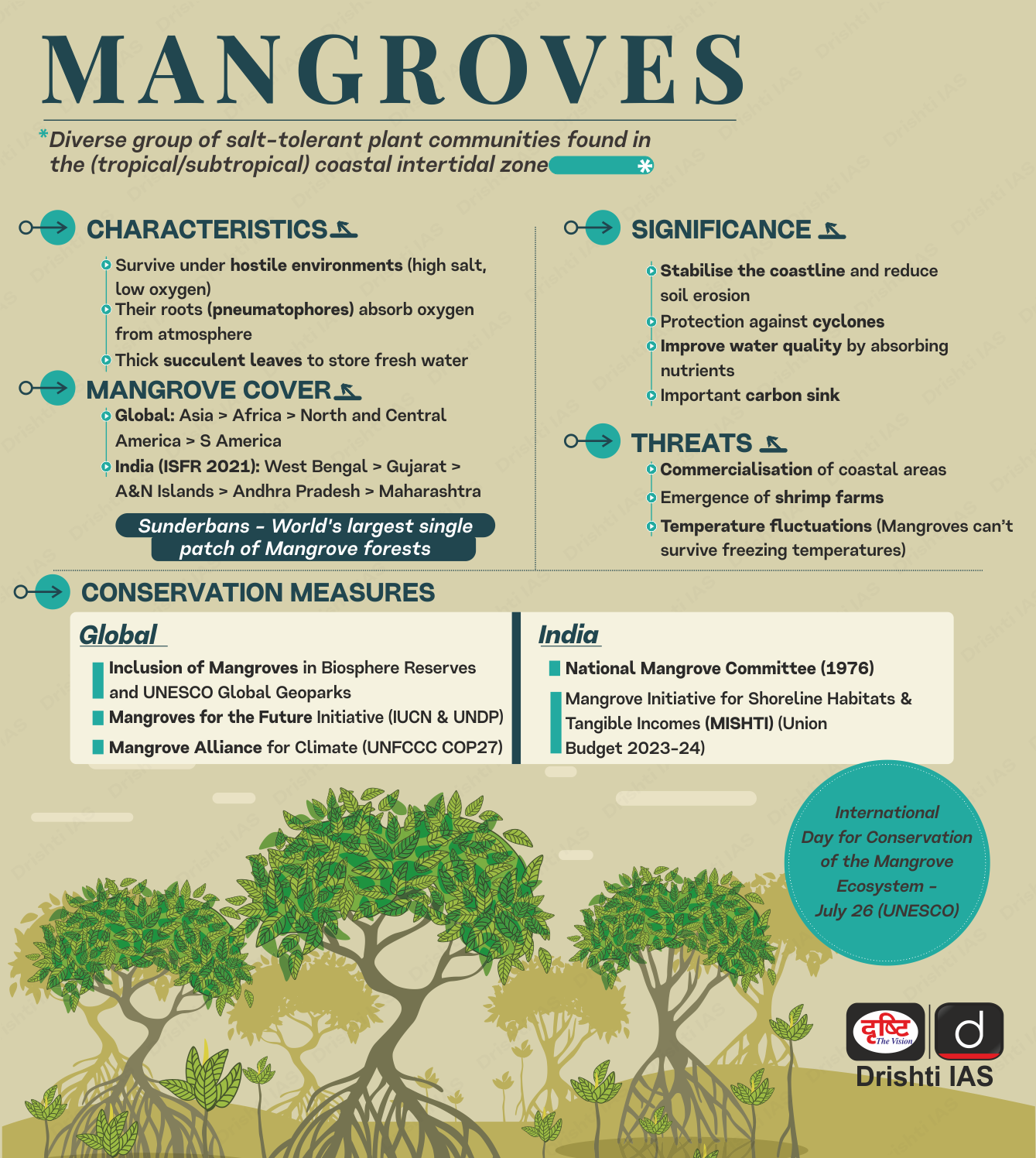Biodiversity & Environment
Mangroves in Coastal Resilience
- 01 Nov 2024
- 8 min read
For Prelims: Bhitarkanika National Park, Indian State Forest Report 2021, MISHTI, Tropical cyclones, Extra Tropical cyclones, MAC
For Mains: Initiatives for protection and conservation of Mangroves, Challenges with Mangrove Conservation, Role of Mangroves in Cyclone Mitigation.
Why in News?
Recently, Cyclone Dana's landfall near Bhitarkanika National Park and Dhamra Port in Odisha underscored the essential role of mangrove forests in reducing cyclone impacts.
- The cyclone did not cause as significant damage as anticipated due to the rich mangrove forest cover of Bhitarkanika.
- Bhitarkanika National Park has withstood the onslaught of several cyclones in the past including the Super Cyclone, which took place in October 1999.
What are Mangroves?
- About: Mangroves are salt-tolerant trees and shrubs that thrive in estuarine and intertidal regions where freshwater meets saltwater.
- They possess unique adaptations, such as aerial roots and waxy leaves, allowing them to survive in saline environments.
- They represent a littoral forest ecosystem, which means they thrive in saline or brackish waters in coastal regions
- Some common mangrove trees include Red mangrove, Grey mangrove, and Rhizophora.
- Mangrove Cover in India: According to the Indian State Forest Report 2021, Mangrove cover in India is 4992 sq. Km which is 0.15% of the country's total geographical area.
- Geographical Distribution: India hosts significant mangrove ecosystems in various states, including Odisha (Bhitarkanika), Andhra Pradesh (Godavari-Krishna delta), Gujarat, Kerala, and the Andaman Islands.
- The Sundarbans (spread across India and Bangladesh) is the largest contiguous mangrove forest in the world. Bhitarkanika is second only to Sunderbans in terms of mangrove cover in India
- Role of Mangroves in Cyclone Mitigation:
- Coastal Defence: Mangroves are the first line of defence for coastal communities. They stabilise shorelines by slowing erosion and provide natural barriers protecting coastal communities.
- Storm Surge Protection: Mangrove forests act as natural barriers against cyclone-driven surges, significantly reducing surge height, water flow velocity, and minimising flooding and coastal damage.".
- Integration with Infrastructure: The effectiveness of mangroves can be enhanced when combined with built infrastructure, such as embankments.
- Initiatives for Protection and Conservation of Mangroves:
- MISHTI Initiative: The Union Budget 2023-24 announced MISHTI initiative for mangrove plantations along the coastline and on salt pan lands.
- Mangrove Alliance for Climate: MAC includes UAE, Indonesia, India, Sri Lanka, Australia, Japan, and Spain. It seeks to educate and spread awareness worldwide on the role of mangroves in curbing global warming and its potential as a solution for climate change.
- Blue Carbon Initiative: It is focused on mitigating climate change through the conservation and restoration of coastal and marine ecosystems.
- It is coordinated by Conservation International (CI), IUCN, and the Intergovernmental Oceanographic Commission-UNESCO (IOC-UNESCO)
What are the Challenges with Mangrove Conservation ?
- Commercialisation of Coastal Areas: Aquaculture, coastal development, rice and palm oil farming and industrial activities are rapidly replacing these salt-tolerant trees and the ecosystems they support.
- Temperature Related Issues: A fluctuation of ten degrees in a short period of time is enough stress to damage the plant and freezing temperatures for even a few hours can kill some mangrove species.
- Soil Related Issues: The soil in which mangroves grow presents a challenge for plants due to its severe lack of oxygen.
- Pollution and Contamination: Pollution from agricultural runoff, industrial discharges, and improper waste disposal contaminate mangrove habitats.
- Lack of Integrated Management: The management of mangroves often occurs in isolation, failing to recognize their crucial interconnectedness with adjacent ecosystems, such as coral reefs and seagrass beds, which is essential for holistic environmental health.
Bhitarkanika National Park:
- Bhitarkanika National Park is spread in a vast area of 672 Kms in Orissa.
- The National Park is essentially a network of creeks and canals which are inundated with waters from rivers Brahmani, Baitarani, Dhamra and Patasala forming a unique ecosystem.
- It is the breeding place for the Saltwater Crocodiles. The crocodile conservation project in Bhitarkanika was started in 1975.
- The Gahirmatha Beach which forms the boundary of the sanctuary in the east is the largest colony of the Olive Ridley Sea Turtles.
What can be Done to Preserve Mangroves?
- Utilise bio-restoration techniques like Assisted Natural Regeneration (ANR) to revive degraded mangrove areas, helping to maintain original biodiversity.
- Assisted Natural Regeneration (ANR) is a complementary solution to planting. This solution consists of a soft forest management method that preserves and strengthens existing forests through forest maintenance work that respects and mimics the natural reproduction cycle of trees.
- There is a pressing need for policies aimed at conserving existing mangrove forests and restoring degraded areas. Sustainable management practices should be adopted to enhance the resilience of coastal ecosystems.
- Engaging local communities in mangrove conservation efforts can foster a sense of ownership and ensure the sustainability of these ecosystems. Education and awareness programs about the benefits of mangroves can promote community-driven conservation initiatives.
Conclusion
Strengthening mangrove conservation efforts is imperative for enhancing India's resilience to cyclones and safeguarding coastal communities. The integration of ecological and infrastructural approaches will be key to achieving long-term sustainability and disaster risk reduction.
|
Drishti Mains Question: Examine the role of mangrove ecosystems in mitigating the impacts of cyclones. Discuss the significance of mangrove preservation in India’s coastal disaster management strategy. |
UPSC Civil Services Examination Previous Year Question (PYQ)
Prelims
Q. Which one of the following regions of India has a combination of mangrove forest, evergreen forest and deciduous forest? (2015)
(a) North Coastal Andhra Pradesh
(b) South-West Bengal
(c) Southern Saurashtra
(d) Andaman and Nicobar Islands
Ans: (d)
Mains
Q. Discuss the causes of depletion of mangroves and explain their importance in maintaining coastal ecology. (2019)






